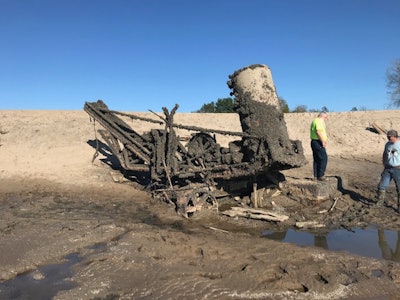
In 1975, Bill Oberloier took the unusual step of obtaining ownership of an old steam shovel.
The unusual part was that the steam shovel was about 25 feet under water and hadn’t been seen on dry land in 70 years.
“My dad liked to collect junk,” recalls his son Mike Oberloier. “When they used to have the local dumps and stuff, we used to take a load of trash there and half a load back.”
Bill Oberloier was talking one day with a relative of the crane’s owner about the old steam shovel that was used to build the Edenville Dam and Wixom Lake in Michigan. The tale was that the crane got stuck, and they couldn’t get it out before the water rushed in to fill the new lake in 1925.
“They got talking about the steam shovel down there,” Mike says. “Then my father kind of got the itch to go find it.”
After obtaining a letter of ownership, Bill Oberloier gathered up a diving expedition. He had a plan to use two barges to try to tow out the shovel if they could locate it.
He started a logbook for an enterprise he planned to call SIMPS Salvage. For the entry on August 25, 1975, he wrote, “SIMPS Salvage Limited – made first attempt at locating a steam shovel in the backwaters of Edenville Dam....”
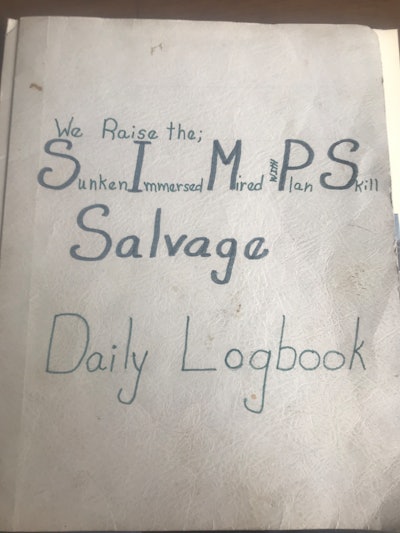 Bill Oberloier's logbook he started for the attempted rescue of the old steam shovel in 1975.Mike Oberloier
Bill Oberloier's logbook he started for the attempted rescue of the old steam shovel in 1975.Mike Oberloier
But the water was too murky. The diver couldn’t go down. They tried using a drag line but no luck in making a firm connection with the shovel.
Bill Oberloier gave up any further rescue attempts. But he did keep his logbook with its one entry. Maybe one day he’d fill it up.
“We talked about it off and on,” Mike says. “It was always mentioned. And people in the area knew the crane was there.”
It was just that Bill Oberloier was ahead of his time.
Almost 45 years later, a 500-year flood event got people in and around Beaverton, Michigan, talking again about the old steam shovel at the bottom of Wixom Lake.
On May 19, 2020, the Edenville Dam broke. Wixom Lake was empty.
“It didn't even cross my mind that the crane was going to be exposed,” says Mike Oberloier. “So next thing you know, my brother and I are getting flooded with emails and texts and pictures: ‘Your dad’s crane is out! You can see your dad’s crane!’”
So Mike and his brother walked down to where the lake used to be and where they had been on that diving expedition in 1975. It had been 16 years since Bill Oberloier had passed away.
“And as we were walking out to it, it's exactly where he said it was when we were out in the boat,” Mike says.
A local news crew and another contractor were out there, too. Mike and Bill let them know about their father owning the crane and staked a claim to it.
“As we left,” Mike says, “I just grabbed a piece of board that was laying there and brought it with me saying, ‘At least I’m going to have a souvenir. At least I'm going to have a piece of the crane.’ Because I didn't think anybody would be able to get the thing out of there or anything else.”
Bill and Mike Oberloier had a photo taken with the old crane. They would put the photo in their father’s old logbook to close the chapter on Bill Oberloier’s steam shovel.
“So we drank some beers and said, ‘Yep, let's do that,’” Mike says. “That was kind of emotional.”
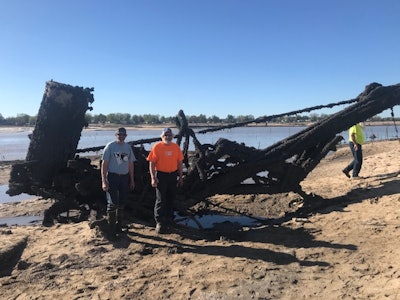 Bill, left, and Mike Oberloier first see their dad's crane after Wixom Lane drained following the Edenville Dam break.Mike Oberloier
Bill, left, and Mike Oberloier first see their dad's crane after Wixom Lane drained following the Edenville Dam break.Mike Oberloier
Bob Kelly, who owns the only restored Type-O Thew steam shovel, contacted Mike Oberloier. Kelly could tell by the photo, it was a Type-O. Always on the hunt for antique steam and electric shovels, Kelly let Mike know he’d be interested in removing and restoring the old Type-O Thew, now only the second one known to exist. (To learn more about Kelly's restored Thew, click here.)
Built in the early 1900s by the Automatic Shovel Company of Lorain, Ohio, the Type-O has a distinctive horizontal crowd to give the bucket a horizontal movement before curving upward. Captain Richard Thew, an ore boat captain on the Great Lakes, invented the Type-O’s unique design to prevent the bucket from damaging the wooden docks when loading and unloading the ore boats.
Kelly found his 1913 Thew Type-O shovel in Ontario, Canada, in 2000 and brought it home to McDonald, Pennsylvania, where he restored it to digging condition. Mike Oberloier agreed to give Kelly first dibs on the newly found steam shovel, if they could find a way to get it out.
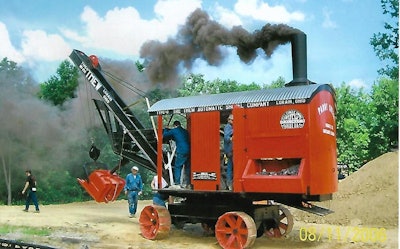 Bob Kelly's 1913 Type-O Thew steam shovel.Bob Kelly
Bob Kelly's 1913 Type-O Thew steam shovel.Bob Kelly
He made some calls to see what would need to be done to get the crane out. He ran into some red tape and had to do some pleading with the Michigan Department of Environment, Great Lakes and Energy. In the meantime, the community was getting excited about the old shovel and hoping something more could be done with it.
The Midland Antique Engine Association asked if Mike wanted to put it on its grounds as a place to restore it. Bill Lang, a contractor who also lended a hand on Bill Overloier’s diving expedition in 1975, worked out a plan to bring in a dozer and excavator to remove the crane.
The more Mike studied the old shovel, took off parts and scraped off the zebra mussels, and the more he heard of the local community’s excitement, he started to change his mind about giving it away.
“And I laid in bed one night and was like, you know, once it goes to Pennsylvania, it’s never coming back,” he says.
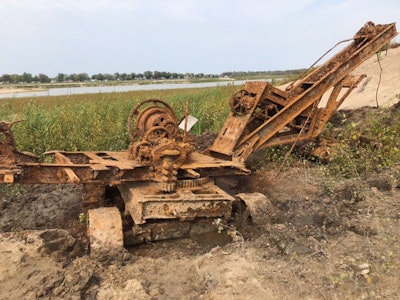 A view of the old shovel at the emptied Wixom Lake after zebra mussels have been removed along with the boiler and water tank.Mike Oberloier
A view of the old shovel at the emptied Wixom Lake after zebra mussels have been removed along with the boiler and water tank.Mike Oberloier
After some back-and-forth and pleading with the state environmental agency, he was able to obtain a $100 permit to remove the crane.
At 8:30 a.m. October 24, everything was ready to go. The volunteers were assembled. The heavy equipment was in place. The local media were there, as were lots of onlookers.
Kelly and his grandson Tommy had left at 3 a.m. from their home in Pennsylvania to be on hand to offer any advice about the rescue operation. The gathered volunteers used an excavator to tow the old shovel out. The boom was removed, and the cast-iron steel wheels rolled through the dark mud on its way to the waiting trailer.
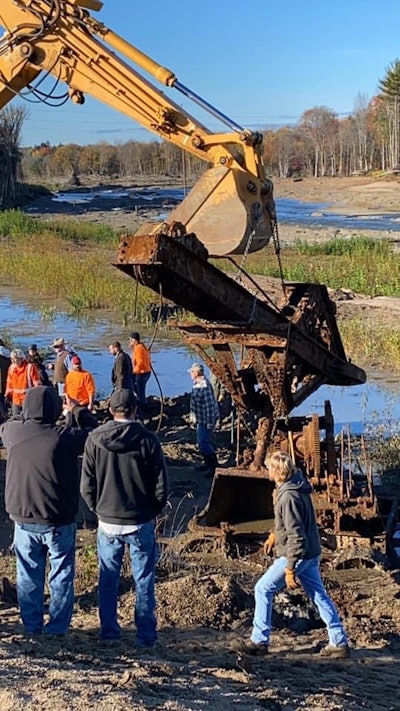 An excavator is used to remove the shovel's boom during the October 24 rescue operation as Bob Kelly and his grandson Tommy (foreground left) look on.Mike Oberloier
An excavator is used to remove the shovel's boom during the October 24 rescue operation as Bob Kelly and his grandson Tommy (foreground left) look on.Mike Oberloier
“It went really well.”
The three-hour operation had safely removed the steam shovel and any parts that could be located, and it was soon on a trailer headed to the Midland Antique Engine Association grounds.
On the day of the rescue, Mike Oberloier wore an orange sweatshirt with a picture of his father's face ironed onto the front.
"I brought him down here with me to be part of this bringing the crane up," he says.
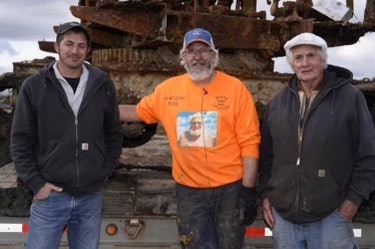 Mike Oberloier wore an orange sweatshirt with his father's picture on the front on the day of the rescue. Here he poses with Thew steam shovel owner Bob Kelly, right, and Kelly's grandson Tommy.Mike Oberloier
Mike Oberloier wore an orange sweatshirt with his father's picture on the front on the day of the rescue. Here he poses with Thew steam shovel owner Bob Kelly, right, and Kelly's grandson Tommy.Mike Oberloier
Mike has removed the three motors. One hoists the bucket, one runs the swing motion and travel, and the third one operates the horizontal crowd movement. Two of the motors have been cleaned, rebuilt, and their parts can move.
Mike couldn’t resist starting a fire in the old boiler after he cleaned it up.
“We threw a fire in there and had some smoke coming out,” he says. “Look it, 95 years later, and we lit the boiler.”
There’s still plenty of work to be done on the 19-ton shovel, likely built sometime between 1907 and 1913. They were unable to find the manufacturer's plate to determine its exact origination date. The wooden house is gone. Some beams on the 19-foot boom need to be replaced. Some of the gears are broken. The boiler has to be replaced.
He plans to use the dimensions of Kelly’s Thew to build the shovel’s house. Mike was also able to find a piece that Kelly needs to complete the restoration of his Thew. He found the mechanism for the “automatic” kickout that enables the bucket to slide up and down the boom, acting almost like a return-to-dig feature does on a modern excavator. Kelly didn’t have that piece, so he will make a pattern of it to replicate.
Though it will take a lot of work, Mike has been surprised at how well-preserved the old shovel is.
“It's amazing how anything that is cast iron is in excellent shape,” he says. “Anything that was cast iron just cleans up cleans up nicely.”
 The old thew Type-O steam shovel gets a power-wash after sitting at the bottom of Wixom Lake for 95 years.Mike Oberloier
The old thew Type-O steam shovel gets a power-wash after sitting at the bottom of Wixom Lake for 95 years.Mike Oberloier
“Once I put that on Facebook, it just went through the roof with people following from all over the world,” he says. “I’ve gotten friend requests from Denmark, New Zealand, Finland, Germany, Australia, the U.K. that are all following this on Facebook.”
An email from an antique steam shovel collector to Mike reads:
“I just want to let you know, whether you believe me or not, this is the most watched thing in the antique equipment community right now. It’s the best thing to come out of 2020, you trying to bring this crane back to life.”
For the Oberloier family, it’s also resurrected a dream – a dream that didn’t end that day in 1975 with Bill Oberloier staring down into the murky waters of Wixom Lake.
(In the video above, Mike Oberloier demonstrates how one of the steam shovel's three motors can move after being cleaned and rebuilt.)










